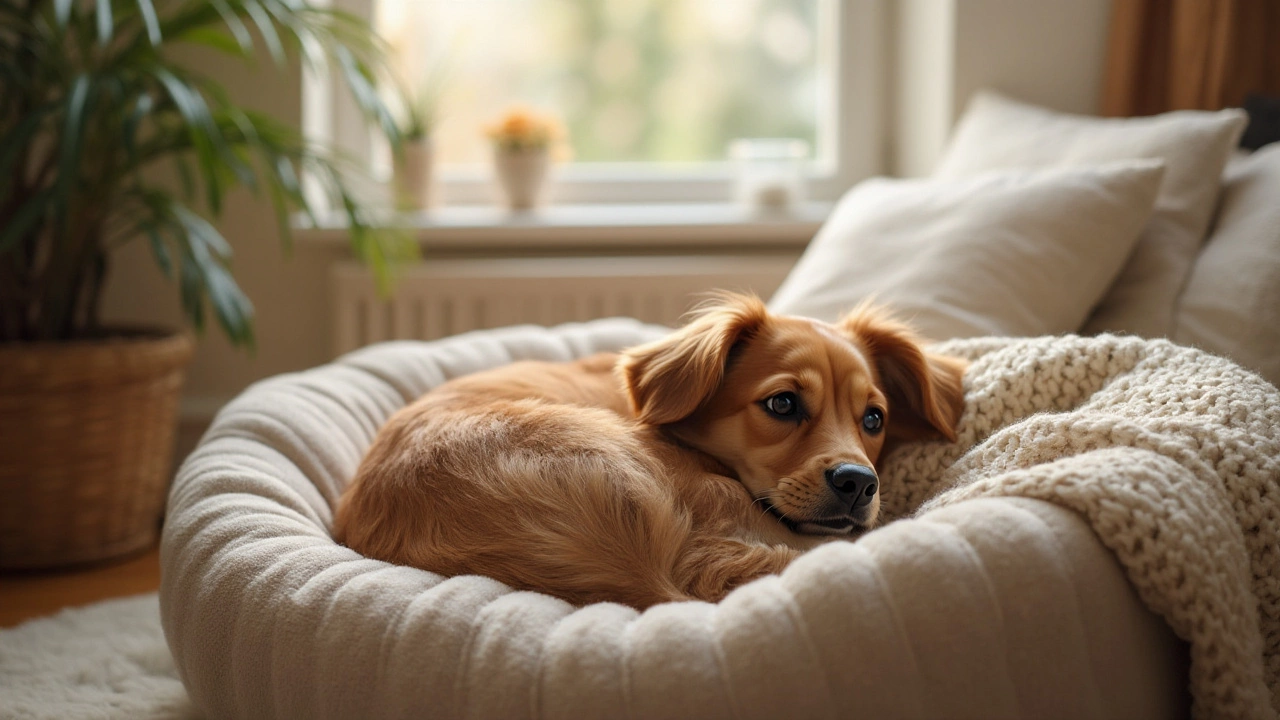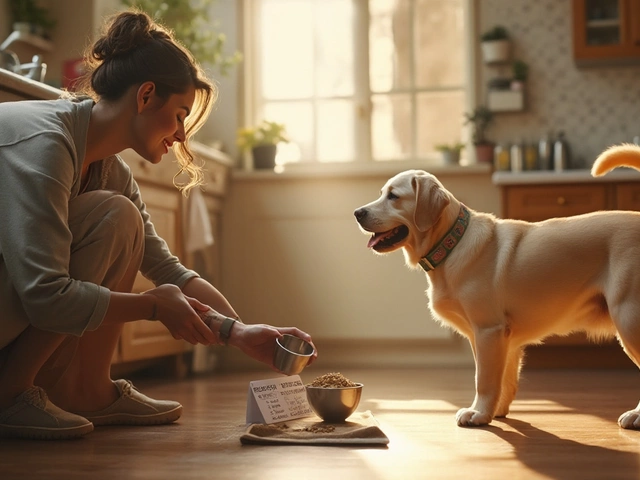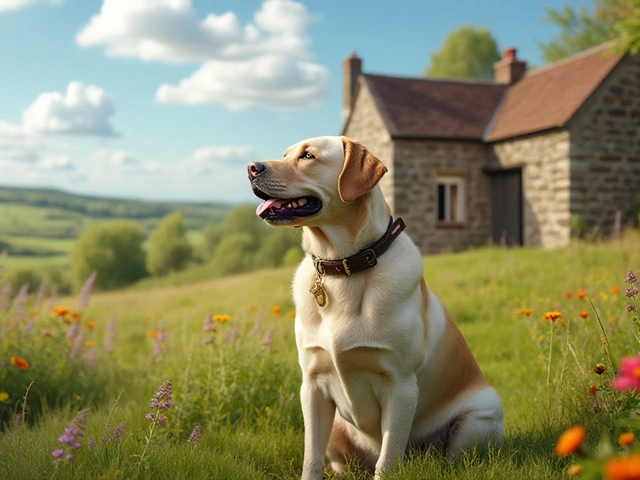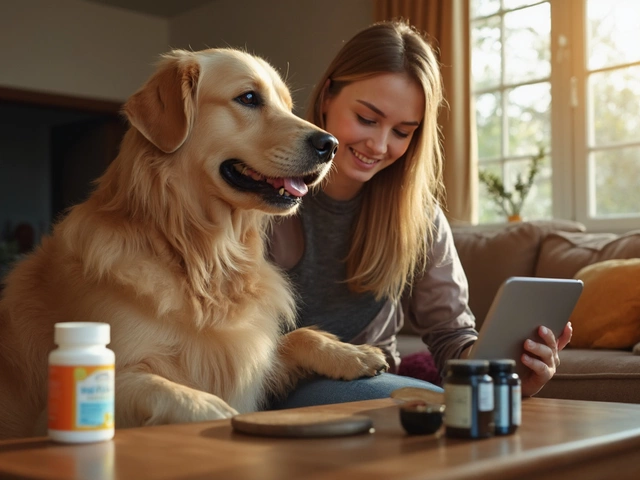Finding the perfect bed for your dog is more than just browsing through options and selecting the prettiest one. Dogs, much like humans, have unique sleeping patterns and preferences that can greatly influence their comfort and relaxation.
A calming dog bed can make a world of difference for your pet's sleep quality, especially if they tend to be anxious or restless. Uncover the essential features of these special beds and how they promote an environment of peace and relaxation for your furry friend.
In this article, we'll dive into what makes these beds a haven for dogs, how to choose the right one, and ways to introduce it to your pet to ensure they feel secure and comfortable.
- Understanding Dog Sleeping Behavior
- Key Features of a Calming Dog Bed
- Benefits of Using a Calming Dog Bed
- Choosing the Right Size and Material
- Tips for Introducing a New Dog Bed
Understanding Dog Sleeping Behavior
Dogs, like any other mammals, have distinct sleeping behaviors that provide insights into their health, comfort, and emotional well-being. Observing a dog’s sleep pattern can sometimes reveal much about their lifestyle, diet, and even underlying health conditions. Most dogs spend around 12 to 14 hours a day snoozing, with puppies and older dogs often requiring even more rest. This is because, during sleep, their bodies are able to repair tissues and consolidate memories, which is essential for growth and cognitive function.
The position in which a dog sleeps speaks volumes about their current state of mind. For instance, a dog curled up in a ball, often seen with their nose tucked under their tail, exhibits a sense of protection. This position helps conserve body heat and protect vital organs in the chest area, harking back to their evolutionary past. On the other hand, a sprawled-out dog, lying on its back with legs splayed, is a sure sign of a dog feeling relaxed and content in its environment since the posture demonstrates vulnerability.
Dogs also enter various stages of sleep, similar to humans. The rapid eye movement (REM) stage is crucial for mental processes and dreaming, and it's during this stage that dogs exhibit twitching or paddling paws, indicating they are actively dreaming. This phase is vital for processing daily experiences and emotions. Interestingly, small dogs tend to have shorter REM cycles, while larger breeds have fewer but longer REM periods.
"The sleep habits of dogs are not just about shutting their eyes—it's deeply connected to their emotional state," explains Dr. Wendy Young, a veterianry behaviorist. "Recognizing these behaviors can help pet owners provide better care and comfort for their furry friends."
Research shows that the quality of a dog's sleep can affect their mood and behavior. Restful sleep is associated with a more stable temperament, while poor sleep can lead to irritability or hyperactivity in dogs, much like it does in humans. Providing a calming dog bed tailored to their natural sleeping habits can significantly improve their sleep quality and overall well-being.
An interesting factor to consider is how the environment influences a dog's sleep. Noise levels, room temperature, and even lighting can impact how easily and deeply a dog can fall asleep. Therefore, a calming dog bed designed with sound-absorbing materials and thermal qualities can enhance their sleep experience, making it important for owners to consider these aspects when selecting a bed.
Key Features of a Calming Dog Bed
When you're hunting for a calming dog bed, there are a few vital features that ensure your pet gets the most restful experience possible. One of the key aspects is the material, which plays a significant role in comforting anxious dogs. High-quality materials like memory foam or orthopedic filling not only provide optimal support but also help alleviate joint pain and pressure points, making them ideal for older dogs or those with arthritis.
Another important feature is the design of the bed, which often includes raised edges or bolsters. These structures mimic the safe feeling of a den, providing a cozy environment where dogs can rest their heads and ease into a peaceful state of mind. According to various pet behavior experts, the presence of bolsters can significantly reduce a pet's anxiety by giving them a sense of security. "The ability to feel enclosed, much like in their natural dens, tends to soothe many dogs," notes a study from the Journal of Veterinary Behavior.
The bed’s cover can also be a game-changer. It’s crucial to find a removable, machine-washable cover for easy maintenance. After all, keeping your dog’s sleeping area clean contributes to their health and well-being. Consider seeking out covers that are not only durable but resistant to odors and allergens, creating both a hygienic and peaceful resting spot.
Size, of course, is paramount. An appropriately sized bed can make a significant difference in comfort levels. Ensure the bed is large enough for your dog to stretch out fully yet snug enough to provide the comforting feel they instinctively seek. For breeds that tend to curl up, opting for a round or donut-shaped bed can enhance their comfort.
The addition of non-slip bottoms is a feature not to be overlooked. Not only does this feature add a layer of safety for more active dogs or slippery floors, but it also prevents disturbances as your pet moves around me. This stability can be particularly comforting for smaller or older dogs who might not adjust well to shifting surfaces.
Calming dog beds often integrate features aimed specifically at anxiety reduction, such as cooling gel layers or built-in heat packs. These elements adjust to your dog's comfort needs, keeping them cool in the summer and warm during the winter. It's like they come with their own built-in thermostat, ensuring your pet remains undisturbed despite fluctuating room temperatures.

Benefits of Using a Calming Dog Bed
Choosing the right bed can transform your dog’s sleeping experience, especially if anxiety is part of their life. A calming dog bed offers multiple benefits that cater to both the emotional and physical needs of your pet. Dogs, by nature, seek snug and cozy spaces that remind them of their denning instincts. A specialized calming bed provides just that, creating a safe environment that helps reduce stress and anxiety. The round shape and raised rims are designed to offer physical support while providing a sense of security, akin to the embrace of a mother's warmth, something deeply rooted in their instincts.
Another significant advantage of calming beds is the improved sleep quality they offer. Just like humans, dogs experience different sleep stages, and reaching the REM stage is crucial for their health and mood. Calming beds are crafted to encourage restful sleeping postures, supporting joints and muscles, which is vital for older dogs or those with arthritis. Memory foam and soft, plush materials are often used, not only for comfort but to distribute the dog's weight evenly. This tailored support helps maintain joint health and alleviates pressure points, ensuring they wake up refreshed and invigorated.
For many pet owners, the durability and cleanliness of a dog comfort bed are of paramount importance. High-quality calming beds are equipped with removable, washable covers that make maintenance straightforward. Ensuring a clean sleeping environment helps in minimizing allergens and reducing the potential spread of ticks and fleas. Investing in a resilient dog bed also means fewer replacements, making it cost-effective in the long run. Pet owners value the practicality of these well-constructed beds, balancing ease of cleaning with the durability necessary to withstand the playful antics of dogs.
The benefits of calming beds extend beyond physical well-being, as they positively impact behavior. Dogs who experience stress often exhibit symptoms such as excessive barking, whining, or destructive activities. The secure and tranquil environment these beds provide helps mitigate anxiety-driven behaviors by offering a retreat that promotes relaxation. Reducing anxiety naturally leads to a calmer demeanor and a more enjoyable companionship. As noted by numerous veterinarians and pet experts, addressing sleep and comfort is often the first step in behavioral training for stressed dogs.
Investing in a calming dog bed is not merely about luxury; it is about enhancing the quality of life for your beloved pet. By providing this specialized care, you are addressing their emotional needs alongside their physical comfort, cultivating a happier, healthier life for your furry friend. In a study published by the American Kennel Club, it was shown that dogs with dedicated resting spaces experienced fewer anxiety episodes compared to those without. This correlation between resting environment and emotional well-being underscores the bed's role in nurturing your dog's overall happiness.
Choosing the Right Size and Material
When it comes to picking out the perfect calming dog beds for your furry friend, size and material are critical factors that can dramatically impact your dog's comfort and sense of security. Choosing the right size involves more than just eyeballing or assuming based on your dog's current bed. Many dogs sleep in a variety of positions, from curling tightly into a ball to sprawling out with limbs extended. Observing these habits can guide you in choosing a bed with enough space for them to stretch and relax comfortably. Ideally, measure your dog while they are in their most common sleeping position and add a few inches to ensure they have adequate space.
The material of the bed is equally paramount, particularly for dogs with sensitivities or specific preferences. Many dog comfort experts suggest that the material should not only provide warmth but also allow for breathability, keeping your pup comfortable across different temperatures. Faux fur and plush materials often mimic the feeling of sleeping beside a mother or pack, offering an added layer of security for anxious pets. Memory foam beds cater well to older dogs or those with joint problems, providing the support they need for a restful slumber. A waterproof liner can also be a smart choice, especially for puppies prone to accidents or senior dogs with incontinence issues.
"Dogs are like family, and ensuring they have a relaxing and cozy space to unwind is pivotal," says Dr. Jenna Mills, a well-respected veterinarian with over 20 years of experience in animal behavior. "Pay attention to their sleeping habits and preferences—it makes all the difference."
Matching Needs with Materials
Beyond basics, there's also the matter of matching the bed’s material to your dog's unique needs. Dogs prone to burrowing, for example, might appreciate beds with raised rims that provide a nook to nestle into, boosting their sense of safety and contentment. Additionally, hypoallergenic materials might be worth considering for dogs prone to allergies, as these can help minimize exposure to dust mites, mold, and other indoor allergens. An often overlooked but essential aspect is the bed's base. Non-slip bottoms help keep the bed stationary, crucial for active dogs who tend to jump in and out with gusto.
The choice of color and design might appeal more to the pet owner than the pet, but it's worth noting that some dogs react differently to various colors. While it sounds like a stretch, studies indicate that certain colors can either calm or excite dogs, so choose carefully based on your pet’s temperament. Also, consider durability—dogs love to chew, and a tough, well-constructed bed will ensure longevity given the right maintenance. Remember, balancing aesthetics with practicality is key when narrowing down the dog sleeping solutions that will best benefit your furry friend.
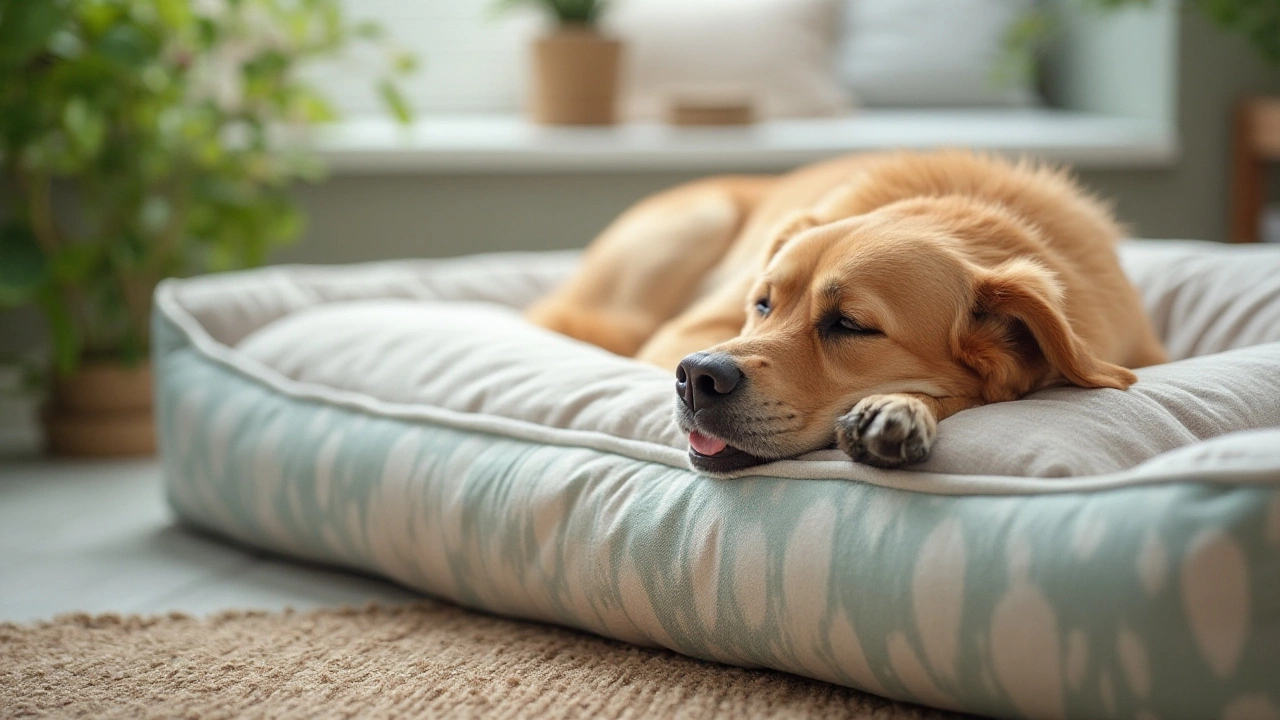
Tips for Introducing a New Dog Bed
Introducing a new bed to your dog is a process that requires patience and understanding of your pet's unique personality. Dogs are creatures of habit, often attached to their smell, and bringing a new item into their domain can be met with cautious curiosity or outright reluctance. The goal is to make the new calming dog bed an inviting space for your furry companion, one they associate with comfort and safety.
Start by placing the new bed in a familiar area where your dog already spends time. This could be a corner in the living room or by the foot of your own bed. Location matters because it needs to be a spot where your dog feels secure. Let your dog explore the bed at their own pace and avoid forcing them onto it. Offering treats as a reward for sniffing or sitting on the bed can create positive associations. Sometimes, using an old blanket or a piece of clothing with your scent can speed up acceptance. Reduce anxiety by maintaining routine during this transition, as consistency gives dogs a sense of stability.
Once your dog shows interest in the bed, encourage them to use it through gentle coaxing and by playing nearby. Dogs usually learn best through association and reinforcement. You might place favorite toys or treats on or around the bed to incentivize them. Remember, it’s essential to be patient, as some dogs might need quite a bit of time to adjust. If your dog seems wary or distrusting, avoid reprimands, as this can exacerbate their hesitation. Instead, maintain a positive approach, as calm and gentle affirmation often works wonders.
"Dogs are not our whole life, but they make our lives whole." - Roger CarasCreating an inviting, stress-free atmosphere is crucial. Consider setting a routine where you guide your dog to the bed at specific times, such as after a walk or during rest periods. This routine helps foster a feeling of ownership. Pay attention to the bed’s placement concerning drafts, sunlight, and noise, as these factors can affect their willingness to lie down and relax.
It’s also worth noting that for some dogs, especially those with anxiety, a transition might be smoother if complemented with calming aids—a popular option for many pet owners. This involves providing relaxation supplements or using soothing pheromone diffusers. Never underestimate the power of praise and occasionally pep up the process with a congratulatory game or cuddle sessions near the bed. These interactions not only make your dog feel loved but significantly boost their confidence in accepting new experiences.
Each dog is unique, showing varying levels of adaptability and openness to change. Remember, patience is key. Be observant of cues your pet gives, and tailor the experience to fit their individual style and preferences. By following these steps, you ensure a serene and welcoming transition to your dog’s new favorite spot for relaxation.
